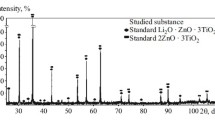Abstract
It is shown to be possible to use some raw materials, both traditional and novel, for synthesizing insulating articles with a diopside crystalline phase. The maximum firing temperature of such articles can be diminished with improvement of the stability of their properties.
Similar content being viewed by others
References
A. I. Avgustinik,Ceramics [in Russian], Stroiizdat, Moscow (1957).
G. N. Maslennikova (Ed.),The Technology of Ceramics [in Russian], Energiya, Moscow (1974).
V. G. Avetikov and É. I. Zin’ko,Magnesia Electrical-Grade Ceramics [in Russian], Energiya, Moscow (1973).
V. P. Petrov (Ed.),High-Magnesia Mineral Raw Materials [in Russian], Nauka, Moscow (1991).
A. I. Shevelev, “Tremolites: a new kind of mineral resources,”Izv. Vuzov, Ser. Geol. Razvedka, No. 6, 86–90 (1980).
L. Z. Reznitskii, E. P. Vasil’ev, V. N. Vishnyakov, et al., “Quartzdiopside rocks of the Southern Baikal region,”Sovet. Geol., No. 3, 54–63 (1989).
L. Z. Reznitskii, V. N. Vishnyakov, E. P. Vasil’ev et al., “Ironfree diopside rocks: a new kind of mineral resource,”Dokl. Akad. Nauk SSSR,303(6), 1434–1437 (1988).
V. I. Vereshchagin, Yu. I. Alekseev, V. M. Pogrebenkov, et al., “Diopside rocks: a universal raw material for the production of ceramic and other silicate materials,”Analitichesk Obzor, Ser. Keram. Prom., Issue 2, VNIIESM (1991).
G. A. Vydrik and N. S. Kostyukov,Physicochemical Foundations of Ceramics Manufacturing and Use [in Russian], Energiya, Moscow (1971).
V. P. Petrov (Ed.),Nonmetallic Natural Resources of the USSR, [in Russian], Nedra, Moscow (1984).
I. F. Romanovich, G. N. Bezrukov, B. A. Bogovskii, et al.,Talc Deposits of the USSR [in Russian], Nedra, Moscow (1973).
A. D. Fedoseev, L. F. Grigor’eva, and T. A. Makarova,Fiber Silicates (Natural and Synthetic Asbestos) [in Russian], Nauka, Moscow-Leningrad (1966).
V. I. Vereshchagin, Yu. I. Alekseev, and P. I. Shatalov, “A new ceramic dielectric from tremolite rocks”,Steklo Keram., No. 1, 18–19 (1987).
G. V. Belinskaya, and G. A. Vydrik,The Technology of Electrovacuum and Radio Engineering Ceramics [in Russian], Energiya, Moscow (1977).
Yu. I. Alekseev, E. P. Vasil’ev, V. I. Vereshchagin, et al., “A high-frequency ceramic based on diopside”,Steklo Keram., No. 8, 21–22 (1987).
Yu. I. Alekseev, A. E. Abakumov, and E. V. Abakumova, “Diopside porcelain,”Steklo Keram., No. 4, 17–19 (1995).
L. P. Konerskaya, R. G. Orlova, É. P. Bogdanis, et al., “Use of datolite and diopside raw materials in electrical engineering”,Steklo Keram., No. 5, 20–22 (1988).
A. S. Berezhnoy,Multicomponent Oxide Systems [in Russian], Naukova Dumka, Kiev (1970).
L. I. Gonzalez and G. G. Ramos, “Modificaciones de una diopsidita por tratamiento termico,”Quimical Industria,29(7–8), 481–484 (1983).
V. I. Babushkin, G. M. Matveev, and O. P. Mchedlov-Petrosyan,The Thermodynamics of Silicates [in Russian], Stroiizdat, Moscow (1986).
G. N. Maslennikova, F. Ya. Kharitonov, N. P. Fomina, and É. A. Sokolina, “Diopside: a raw material for high-frequency ceramics”,Steklo Keram., No. 11, 21–22 (1987).
E. P. Vasil’ev, L. Z. Reznitskii, V. N. Vishnyakov, and E. A. Nekrasova,The Slyudyansk Crystalline Complex [in Russian], Nauka, Novosibirsk (1981).
M. Cameron, S. Sueno, C. T. Prewitt, and I. I. Papike, “Hightemperature crystal chemistry of acmit, diopside, hedenbergite, jadeite, spodumene and ureyite”,Am. Mineralogist,58, 594–618 (1973).
U. O. Joshikas and W. B. Carbes, “Clinopyroxene lattice deformation: the roles of chemical substitution and temperature”,Am. Mineralogist,58, 843–849 (1973).
G. M. Azarov, A. S. Vlasov, E. V. Mayorova, and M. A. Oborina, “Diopside: a raw material for the production of porcelain”,Steklo Keram., No. 8, 20–22 (1995).
B. M. Tareev,The Physics of Dielectric Materials [in Russian], Énergiya, Moscow (1973).
Yu. I. Alekseev and Yu. I. Galanov, “Electrical conductivity of diopside ceramics”,Steklo Keram. No. 1, 26–27 (1990).
Author information
Authors and Affiliations
Additional information
Translated from Steklo i Keramika, No. 12, pp. 15–19, December, 1997.
Rights and permissions
About this article
Cite this article
Alekseev, Y.I. Ceramic insulating materials with a diopside crystalline phase. Glass Ceram 54, 394–398 (1997). https://doi.org/10.1007/BF02766761
Issue Date:
DOI: https://doi.org/10.1007/BF02766761




